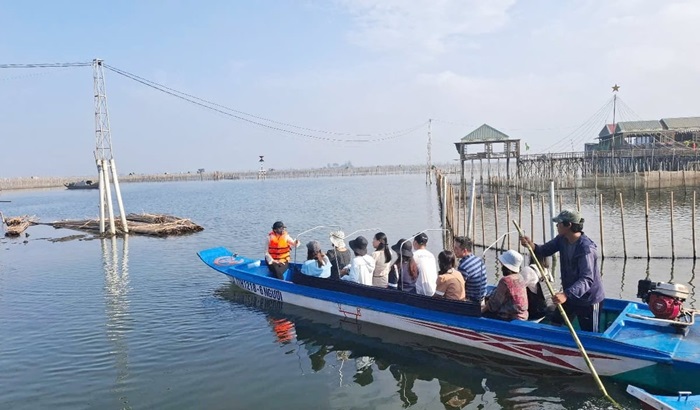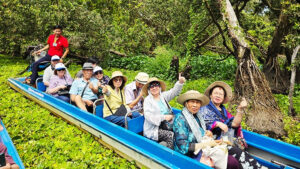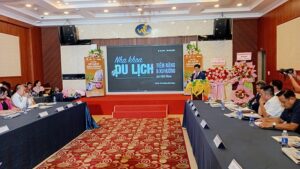A new conservation designation of the Convention on Biological Diversity (CBD) promises more opportunities for Việt Nam to boost conservation work in the country, experts have said.

Species of rare primates with scientific name Pygathrix nemaeus nigripes are facing extinction in Viet Nam. — Photo daidoanket.vn
The CBD, to which Viet Nam is a party, has recently agreed a new conservation designation that complements protected areas and this is an opportunity for Viet Nam to extend and connect the country’s conserved areas by identifying and legally recognising “other effective area-based conservation measures or OECMs," according to Jake Brunner, head of the IUCN, International Union for Conservation of Nature, Indo-Burma Group.
Brunner highlighted the new step of the CBD and how Viet Nam will benefit, saying that OECMs are a chance for Viet Nam to both recognise the contributions to the conservation of biodiversity occurring outside of protected areas and to incentivise conservation outside of protected areas through recognition and support.
“Viet Nam is home to several large agricultural dominated landscapes that include areas of high biodiversity value and/or are the target of restoration to reestablish natural ecosystem functions for climate change and biodiversity benefits. Within these landscapes there are opportunities to recognise OECMs,” Brunner said.

Rare birds in Dong Thap Muoi Natural Reserve are among the wild species that need urgent preservation. — VNA/VNS Photo Nam Thai
In a statement released last week on the website of the IUCN, the expert gave some examples of conservation areas that the country should be focusing on.
In the Mekong Delta, a key Government aim is to de-intensify rice production to reconnect the Mekong’s flood plain and restore ecosystem functions.
“This opens up the possibility of transitioning hundreds of thousands of hectares in the upper delta out of the third or even second rice crop into higher value flood-friendly livelihoods. As well as increasing flood and drought resilience, this will restore capture fisheries and aquatic and agro-biodiversity. Parts of these restored areas may be recognised as OECMs,” added Brunner.
In Ha Noi, Brunner pointed out an opportunity to convert the southern tip of Bai Giua Song Hong, the 300-hectare island in the middle of the Red River, into one of the city’s few green spaces. Some 300 species of birds have been recorded there.
Meanwhile, Nguyen Duc Tu, a conservationist and head of IUCN Biodiversity Programme in Viet Nam said OECM helps the country fulfill conservation commitments, and protects habitats with high biodiversity which are at high risk, such as isolated karst areas, seasonally inundated grasslands and coastal mudflats.
"OECMs also offer an opportunity to recognise contributions to biodiversity conservation by businesses and communities by improving the efficiency of the management of the land they are allowed to use," according to Tu.
The expert said Viet Nam has OECMs, such as "no-enter areas"; sacred areas, military zones, war ruins, and other "prohibited" areas (dependent); areas preserved by low-impact use, watershed protection areas, and wetlands related to ecosystem services (secondary); private land areas for conservation as the first purpose, and areas which cannot or don’t want to be registered as protected areas (primary).In particular, it can improve biodiversity conservation of various sectors, including the business sector which is considered to be outside biodiversity conservation efforts; and supplement the list of CSR (corporate social responsibility) activities of businesses that have large land plots, ensuring biodiversity in development projects, Tu said.
The CBD, first being opened for signatures at the Earth Summit in Rio de Janeiro in June 1992 and entered into force in December 1993, is a multilateral treaty, often seen as the key document regarding sustainable development with three main goals, including: the conservation of biological diversity (or biodiversity); the sustainable use of its components; and the fair and equitable sharing of benefits arising from genetic resources.
Its objective is to develop national strategies for the conservation and sustainable use of biological diversity.
Parties to the CBD adopted the OECM as well as its guiding principles, common characteristics and criteria for identification in November 2018.
Protected areas in Viet Nam
In 2014, Prime Minister’s Decision 1976 proposed expanding coverage to 2.4 million hectares, or about 7 per cent of Viet Nam’s land area, by 2020 and today coverage has almost reached this target.
Nevertheless, there is little prospect of Viet Nam legally protecting 17 per cent of its land area by 2020 as defined by CBD Target 11.
One reason for the slow-down in expanding the protected area network over the last 20 years is competition over land and water in a rapidly developing country of 96 million.
Another factor is the limited funding available for protected area management. With resources stretched thin and management effectiveness already low, there is little appetite to add to the protected area coverage, according to the report.














